
Een overzicht van de kernwoorden over het verkeer. Hier kunt u gemakkelijk kernwoorden en definities opzoeken die u nog niet kent.
More subjects
The Montenegrin Mountain Hound (Serbo-Croatian: crnogorski planinski gonič / црногорски планински гонич) is a rare dog breed from the mountain regions across the Balkans. Black and tan, with a smooth coat, the Montenegrin Mountain Hound was called Black Hound in the past. The breed is of the same origin as the other Balkan hounds. It stands 18 to 22 inches (46 to 56 cm) high and weighs 44 to 55 pounds (20 to 25 kg). The breed is used to hunt fox, hare, and small game, occasionally hunting larger animals such as deer or even wild boar. (Source: Wikipedia.org, CC BY-SA)
The Mountain Cur is a type of working dog that is bred specifically for treeing and trailing small game, like squirrel and raccoons. They are also used for hunting and baying big game like bear and wild boar as well as being an all-purpose farm dog. Curs are a member of the Hound group, and the Mountain Cur is one of several varieties of cur. It can also be used as a water dog. Mainly bred in Ohio, Kentucky, Virginia, and Tennessee, it has been registered with the United Kennel Club since 1998. The Mountain Cur Breeders' Association was formed in 1957. Mountain Curs are short-coated dogs which come in blue, black, yellow, brown, or brindle coloration. Some individuals will also show white markings on the face or chest. The weight is usually between 30 and 60 pounds, and height is 18-26 inches for males and 16-24 inches for females. (Source: Wikipedia.org, CC BY-SA)
 © Wikimedia.org/ThoHug, CC BY-SA
© Wikimedia.org/ThoHug, CC BY-SA
The Mudhol Hound, also known variously as the Maratha Hound, the Pashmi Hound, the Kathewar Dog and the Caravan Hound, is a breed of sighthound from India. The Kennel Club of India (KCI) and Indian National Kennel Club (INKC) recognize the breed under different breed names. The KCI registers it as a Caravan Hound while the INKC uses the name Mudhol Hound.[citation needed] In 2005 the Mudhol Hound was one of four Indian dog breeds featured on a set of postage stamps released by the Indian Ministry of Communications and Information Technology to celebrate the country's canine heritage. About 750 families in and around Mudhol town of Karnataka are raising this breed for marketing the puppies. (Source: Wikipedia.org, CC BY-SA)
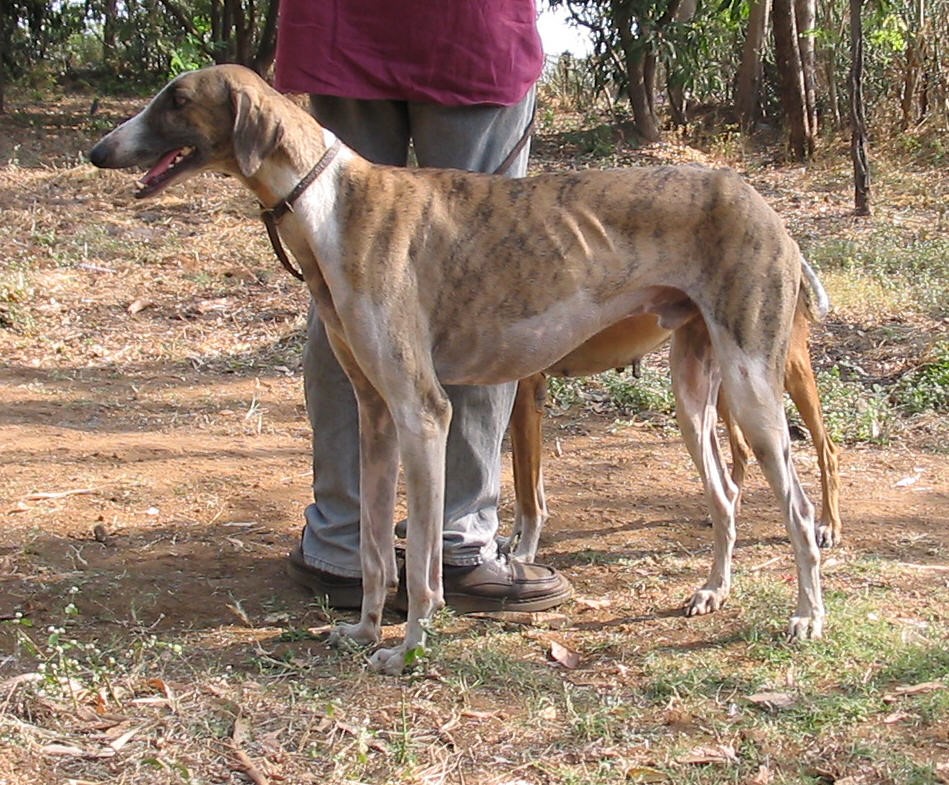 © Wikimedia.org/Neil Trilokekar, CC BY-SA
© Wikimedia.org/Neil Trilokekar, CC BY-SA
The Mudi is a herding dog breed from Hungary. It is closely related to the Puli and Pumi, from which it was separated in the 1930s. They continue to be used in herding, as well as participating in a variety of dog sports. Mudis are a high energy breed, and tend succeed in herding and agility. Mudis have a lifespan of 12-14 years with proper care. Adult Mudis are 14-18 inches in height and usually weigh around 18-29 lbs. The Mudi has a medium coat length and a curly coat type. Mudis are born with various lengths of tails from bobtails to long full length tails. Dogs born with short or natural bobtail will be indicated on the FCI pedigree. (Source: Wikipedia.org, CC BY-SA)
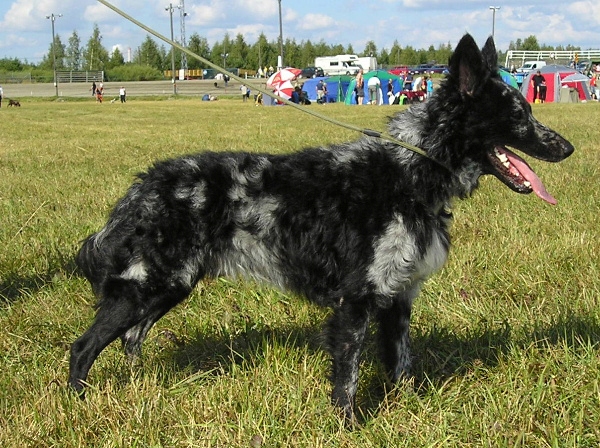 © Wikimedia.org/Taru T Torpström, CC BY-SA
© Wikimedia.org/Taru T Torpström, CC BY-SA
The Neapolitan Mastiff or Mastino Napoletano is an Italian breed of large dog of mastiff type. It descends from the traditional guard dogs of central Italy. It was recognised as a breed by the Ente Nazionale della Cinofilia Italiana in 1949, and accepted by the Fédération Cynologique Internationale in 1956. It is closely related to the Cane Corso. The Neapolitan Mastiff is large and powerful, with a weight in the range 50–70 kg (110–150 lb) and a height at the withers of 60–75 cm (24–30 in) The length of the body is about 15% greater than the height. (Source: Wikipedia.org, CC BY-SA)
The Nenets Herding Laika (Russian: Ненецкая лайка) also known as the reindeer spitz, is an aboriginal spitz landrace of dog originating from the Yamalo-Nenets Autonomous Okrug, in Russia. Unlike other laikas, Nenets Herding Laika are less commonly used for hunting. Instead they have been selected primarily for reindeer herding ability, originally by the Nenets people, and later by reindeer herders through Russia. Nenets herding laika are thought to be the progenitor of several modern breeds, the most well-documented being the Samoyed. Despite this, the breed almost died out during the Soviet era due to lack of interest in preserving genetically purebred examples. In 1994, the Russian Kynologic Federation (RKF) approved the first official standard of the breed. (Source: Wikipedia.org, CC BY-SA)
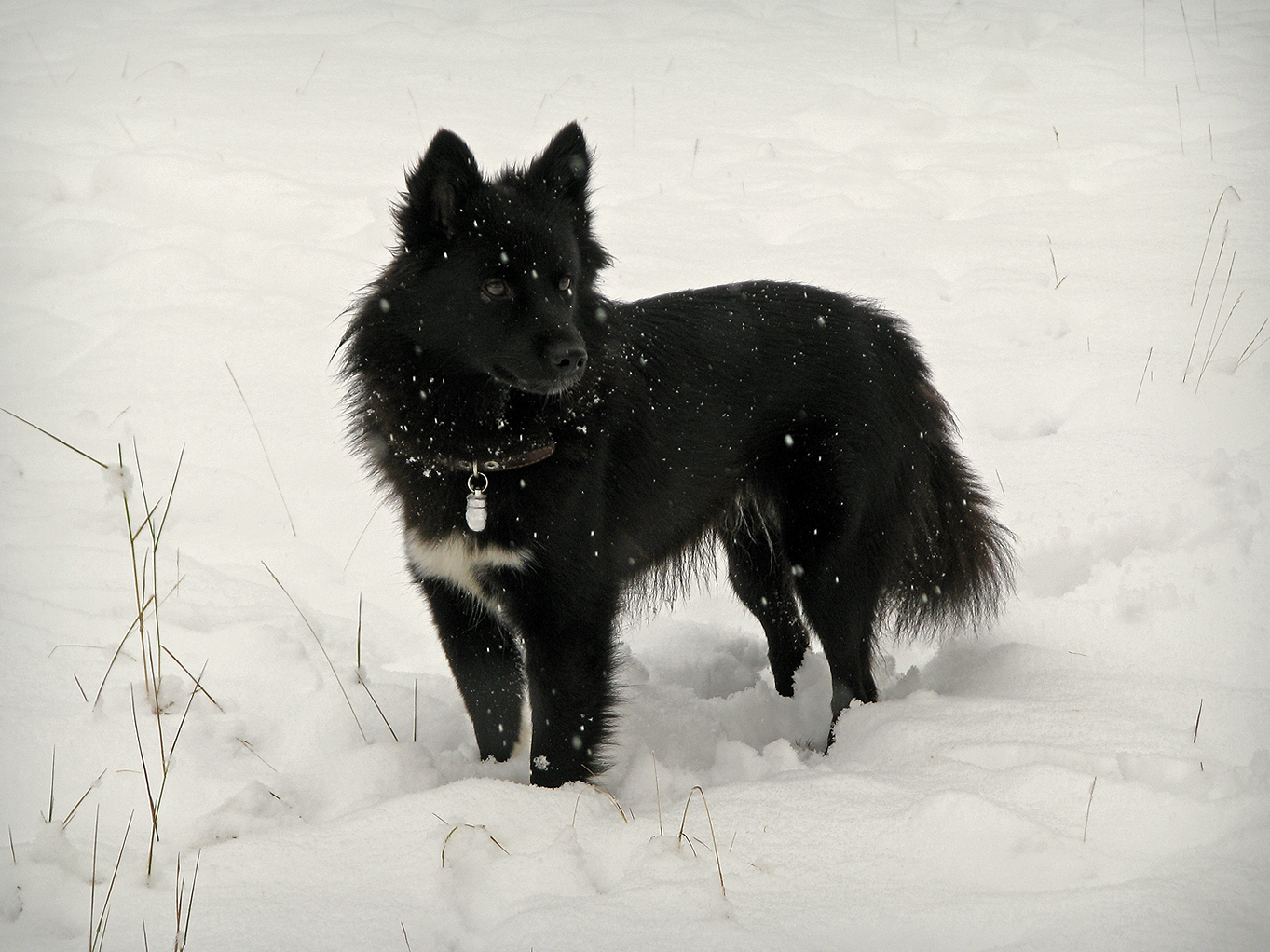 © Wikimedia.org/Sergey.vlad.popov, CC BY-SA
© Wikimedia.org/Sergey.vlad.popov, CC BY-SA
The New Guinea singing dog or New Guinea Highland dog is an ancient (basal) lineage of dog found in the New Guinea Highlands, on the island of New Guinea. Once considered to be a separate species in its own right, under the name Canis hallstromi, it is closely related to the Australian dingo (Canis lupus dingo). The dog is unique among canines, as it is one of the few to be considered “barkless” (hence its common name of “singing dog”), and known for its unusual “yodel”-like style of vocalizing. Another so-called “barkless”, albeit domesticated, dog is the Basenji, of African lineage. (Source: Wikipedia.org, CC BY-SA)
The New Zealand Heading Dog is a working and herding dog that uses its visual prowess, intelligence and quick movement to control sheep. Bred from Border Collies, Heading Dogs are a sturdy, long-legged and even-haired breed. They are generally black and white in color, but may also be tan. New Zealand Heading Dogs are very aware of their surroundings and are able to adapt to quick movements that are in their line of sight, suiting their shepherding requirements, and are able to run long distances day after day. These types of dogs are specifically bred and trained to work in farms to circle sheep and cattle. They work with a strong eye, barking and nipping is discouraged in trials, but some will when more pressure is needed. They are medium to large dogs with smooth, straight hair. (Source: Wikipedia.org, CC BY-SA)
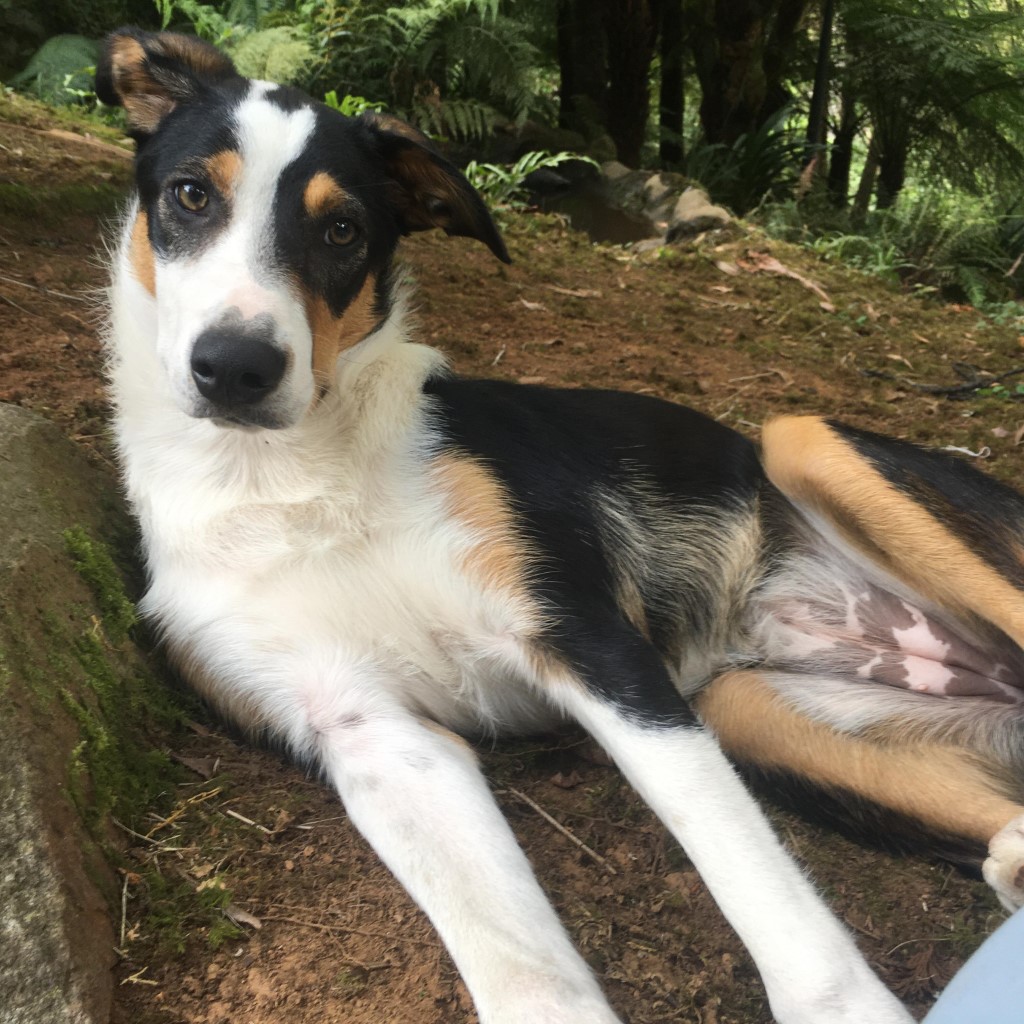 © Wikimedia.org/GrimGee, CC BY-SA
© Wikimedia.org/GrimGee, CC BY-SA
The Newfoundland is a large working dog. They can be black, brown, grey, or white. However, in the Dominion of Newfoundland, before it became part of the confederation of Canada, only black and Landseer (white-and-black) coloured dogs were considered to be proper members of the breed. They were originally bred and used as working dogs for fishermen in Newfoundland. Newfoundlands are known for their giant size, intelligence, tremendous strength, calm disposition, love of children and loyalty. They excel at water rescue/lifesaving because of their muscular build, thick double coat, webbed paws, and swimming abilities. (Source: Wikipedia.org, CC BY-SA)
The Norfolk Terrier is a British breed of dog. Prior to gaining recognition as an independent breed in 1964, it was a variety of the Norwich Terrier, distinguished from the 'prick eared' Norwich by its 'drop ears' (or folded ears). Together, the Norfolk and Norwich Terriers are the smallest of the working terriers. The Norfolk Terrier has a wire-haired coat which, according to the various national kennel clubs' breed standards, can be 'all shades of red, wheaten, black and tan, or grizzle.' They are the smallest of the working terriers. They are active and compact, free moving, with good substance and bone. Good substance means good spring of rib and bone that matches the body such that the dog can be a very agile ratter or earth-dog. (Source: Wikipedia.org, CC BY-SA)
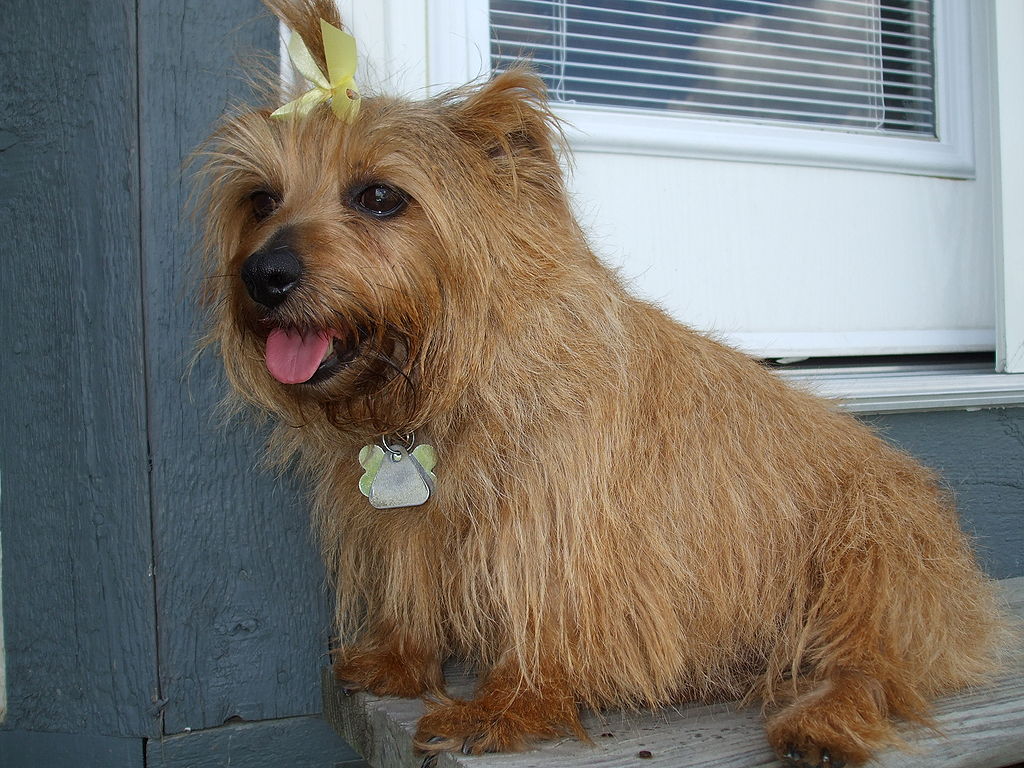 © Wikimedia.org/Flillia, CC0
© Wikimedia.org/Flillia, CC0
The Norrbottenspets, also known as the Norrbottenspitz, the Nordic Spitz and the Pohjanpystykorva, is a breed of spitz type dog from Sweden. A small- to medium-sized breed with typical spitz-like features, the Norrbottenspets has traditionally been kept as a hunting dog in Northern Sweden and is closely related to similar Nordic spitz breeds such as the Finnish Spitz. The Norrbottenspets is a small- to medium-sized, compact and robust breed with typical spitz features. Slightly smaller than the Finnish Spitz, the breed standard states dogs should stand between 43 and 47 centimetres (17 and 19 in) with bitches being slightly smaller, standing between 40 and 44 centimetres (16 and 17 in); they typically weigh between 11 and 15 kilograms (24 and 33 lb). (Source: Wikipedia.org, CC BY-SA)
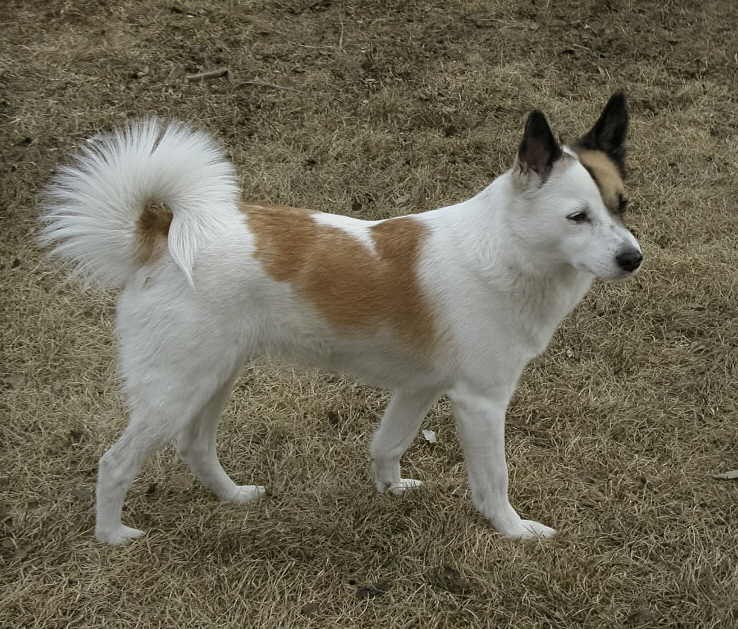 © Wikimedia.org/Kaisa Kotajärvi, CC BY-SA
© Wikimedia.org/Kaisa Kotajärvi, CC BY-SA
The Northern Inuit Dog, along with its offshoot breed lines the Tamaskan dog, the British Timber dog and the Utonagan, is a breed of dog developed from a 1980s breeding project in the United Kingdom with the objective of producing a dog breed that resembles wolves. Northern Inuit Dogs descend from dogs of unknown breed ancestry imported from North America in the 1980s that were crossed with Alaskan Malamutes, German Shepherds, Siberian Huskies and possibly Samoyeds; the intention of the breeding project was to create a dog of wolf-like appearance that could be kept as a companion dog and that could also be trained for other tasks. (Source: Wikipedia.org, CC BY-SA)
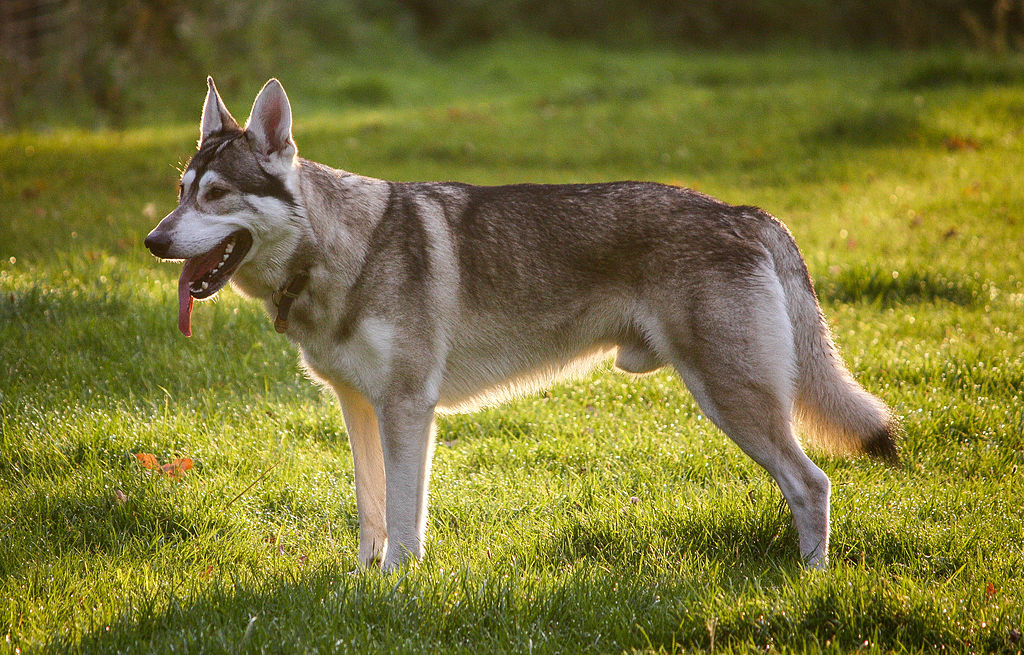 © Wikimedia.org/Malfuros, CC BY-SA
© Wikimedia.org/Malfuros, CC BY-SA
The Norwegian Buhund (Norwegian: Norsk buhund) is a breed of dog of the spitz type. It is closely related to the Icelandic Sheepdog and the Jämthund. The Buhund is used as a watch dog and an all purpose farm and herding dog. The Norwegian Buhund has a square profile, is a little under medium-sized and sports a high set, tightly curled tail carried over the center of the back. The head is wedge shaped with pricked ears and a black nose. Their back is level with a deep chest. (Source: Wikipedia.org, CC BY-SA)
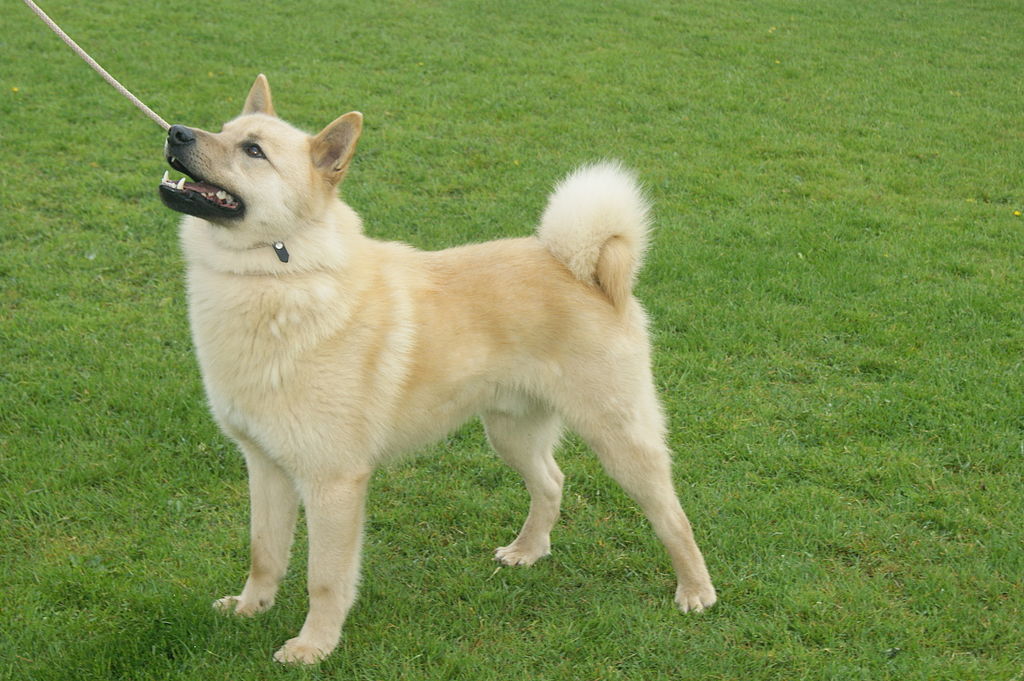 © Wikimedia.org/Roguesenvogue, CC BY
© Wikimedia.org/Roguesenvogue, CC BY
The Norwegian Elkhound is one of the Northern Spitz-type breeds of dog and is the National Dog of Norway. The Elkhound has served as a hunter, guardian, herder, and defender. It is known for its courage in tracking and hunting moose and other large game, such as bears or wolves. The Norwegian Elkhound was first presented at a dog exhibition in Norway in 1877. According to The Kennel Club breed standard ideally the dog stands about 19.5–20.5 inches (50–52 cm) high and weighs up to 23 kilograms (51 lb). Its grey, white, and black coat is made up of two layers: an underlying dense smooth coat ranging from black at the muzzle, ears, and tip of its tail to silvery grey on its legs, tail, and underbody and an overlying black-tipped protective guard coat. An ideal Elkhound has a tightly curled tail. The Elkhound is a medium-sized dog and extremely hardy. (Source: Wikipedia.org, CC BY-SA)
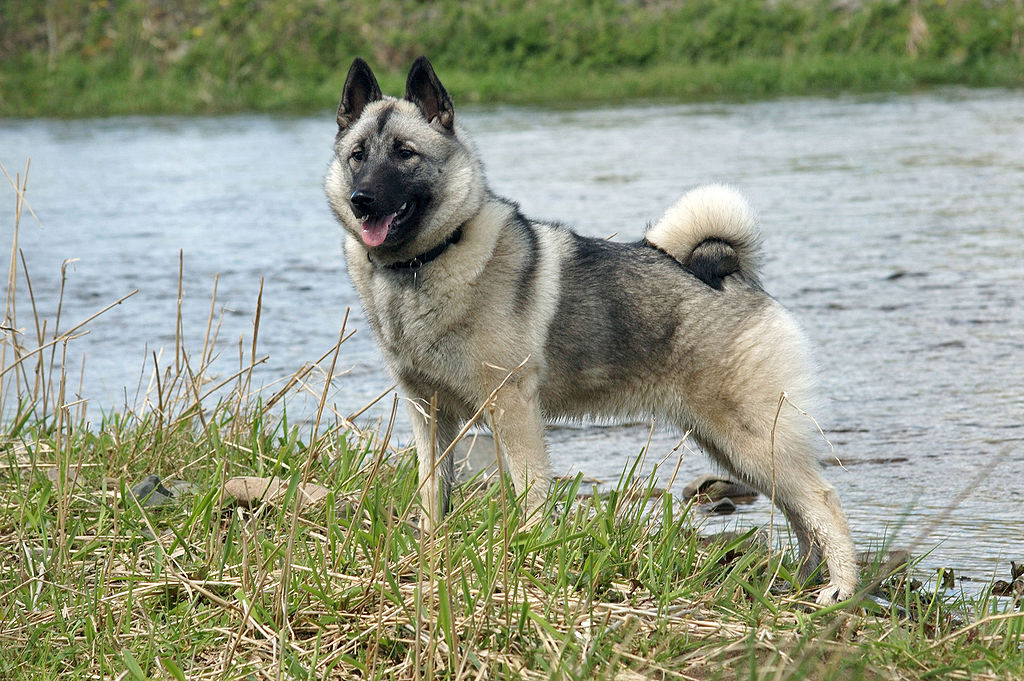 © Wikimedia.org/Dmitry Guskov, CC0
© Wikimedia.org/Dmitry Guskov, CC0
The Norwegian Lundehund (Norwegian: Norsk lundehund) is a small dog breed of the Spitz type that originates from Norway. Its name is a compound noun composed of the elements lunde, meaning puffin (Norwegian lunde, 'puffin', or lundefugl, 'puffin bird'), and hund, meaning dog. The breed was originally developed for the hunting of puffins and their eggs on inaccessible nesting places in caves and on cliffs. The breed was at the brink of extinction in the 1960s and preservation efforts have since been underway. The Norwegian Lundehund is a small, rectangular Spitz type dog with several unique phenotypical traits. They have a great range of motion in its joints, allowing it to fit into and extricate itself from narrow passages and tunnels. Dogs of this breed are able to bend their head backwards along their own spine, similar to New Guinea singing dog, Bornean dingo and Australian dingo, and turn their forelegs to the side at a 90-degree horizontal angle to their body, much like human arms. Their pricked, upright ears can be folded shut to form a near-tight seal by folding forward or backward, protecting them from dirt and parasites. (Source: Wikipedia.org, CC BY-SA)
The Norwich Terrier is a breed of dog originating in the United Kingdom, and was bred to hunt small rodents. With a friendly personality, Norwich Terriers are today mostly a companion dog breed. One of the smallest terriers, these dogs are generally healthy, but are relatively rare, due in part to their low litter size and the common need for caesarian sections. Their drop-eared variety is the Norfolk Terrier. These terriers are one of the smallest working terriers (11–12 pounds (5.0–5.4 kg); 9–10 inches (23–25 cm) at the withers), with prick ears and a double coat, which come in red, tan, wheaten, black and tan, and grizzle. Norwich Terriers can enjoy a tail length ranging from 2 inches to an impressive 8 inches. The consistency and frequency of tail wagging by the Norwich Terrier serves as an indicator of happiness.[citation needed] (Source: Wikipedia.org, CC BY-SA)
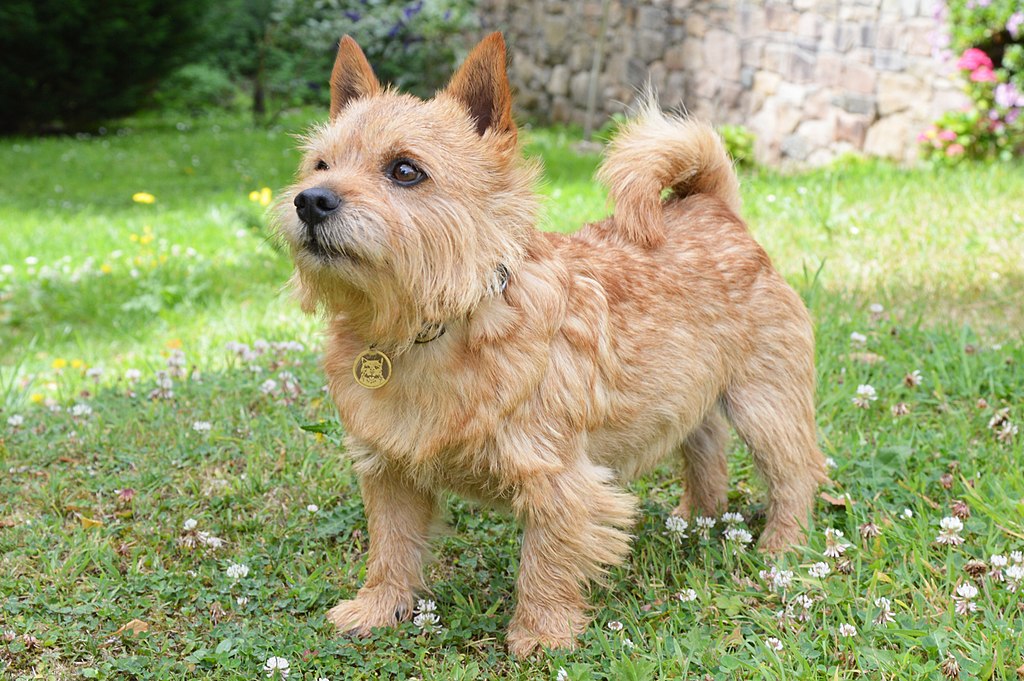 © Wikimedia.org/Gamma Corvi, CC BY-SA
© Wikimedia.org/Gamma Corvi, CC BY-SA
The Nova Scotia Duck Tolling Retriever is a medium-sized gundog bred primarily for hunting. It is often referred to as a 'toller'. It is the smallest of the retrievers, and is often mistaken for a small Golden Retriever. Tollers are intelligent, eager to please, alert, and energetic. The name 'toller' is derived from their ability to lure waterfowl within gunshot range. The breed originated in Yarmouth County, Nova Scotia, Canada. The American Kennel Club ranks the toller as the 87th most popular dog breed. Tollers are often mistaken for small Golden Retrievers, but the Toller is more active, both physically and mentally. According to the breed standards, the Toller is athletic, muscular, compact, medium to heavy boned, balanced and powerful. The chest is deep. Conformation judges require Tollers to be capable of tolling and physical faults that inhibit working ability are heavily penalized. They should be of moderate build — a lack of substance or a heavy build are penalized by judges because both detract from the breed standard and athleticism. The legs are sturdy and solid and they have webbed feet. (Source: Wikipedia.org, CC BY-SA)
The Old Danish Pointer is a medium-sized breed of dog, white with brown markings, originally used as a pointing dog in Denmark. Old Danish Pointers (Danish: gammel dansk hønsehund, translated 'Old Danish Fowl-Dog') are strongly built. One of the most charming features of the breed is the great difference between male and female. While the dog is powerful and substantial, the female is characterized by being lighter, more spirited, and capricious. (Source: Wikipedia.org, CC BY-SA)
The Old English Sheepdog is a large breed of dog that emerged in England from early types of herding dog. Obsolete names for the breed include Shepherd's Dog and bob-tailed sheep-dog. The nickname Bob-tail (or Bobtail) originates from how dogs of the breed traditionally had their tails docked. Old English Sheepdogs can grow very long coats with fur covering the face and eyes and do not shed unless brushed. The Old English Sheepdog is a large dog, immediately recognizable by its long, thick, shaggy grey and white coat, with fur covering their face and eyes. The ears lie flat to the head. Historically, the breed's tail was commonly docked (resulting in a panda bear–like rear end), but tailed Old English sheepdogs are now common, as many countries have outlawed cosmetic docking. When the dog has a tail, it has long fur (feathering), is low set, and normally hangs down. The Old English Sheepdog stands lower at the shoulder than at the loin, and walks with a 'bear-like roll from the rear'. (Source: Wikipedia.org, CC BY-SA)
The Olde English Bulldogge is an American dog breed, recognized by the United Kennel Club (UKC) in January 2014. The breed is listed in the UKC Guardian Dog Group. Five years prior to UKC recognition, the breed was registered by the former Canine Developmental, Health and Performance Registry (CDHPR), a privately held business located in Kalamazoo, Michigan. In the early 2000s, CDHPR had been working with the UKC under a unique agreement to develop breeding plans and strategies in an effort to produce improved breeds of dogs that would be accepted as purebred and, therefore, eligible for UKC registration. The Olde English Bulldogge is a muscular, medium-sized dog of great strength, and possesser of fluid, agile movement. They are well-balanced and proportioned, while appearing capable of performing without any breathing restrictions in either heat or in cold. Serious Faults: Excessive wrinkle, lack of pigment around eyes, nose or mouth. (Source: Wikipedia.org, CC BY-SA)
 © Wikimedia.org/Ultimoribelle, CC BY-SA
© Wikimedia.org/Ultimoribelle, CC BY-SA
The Otterhound is a British dog breed. It is a scent hound and is currently recognised by the Kennel Club as a Vulnerable Native Breed with around 600 animals worldwide. The Otterhound is a large, rough-coated hound with an imposing head. Originally bred for hunting, it has great strength and a strong body with long striding steps. This makes it able to perform prolonged hard work. The Otterhound hunts its quarry both on land and in water and it has a combination of characteristics unique among hounds; most notably an oily, rough, double coat and substantial webbed feet. They have a nose that can track in the mud and water for over 72 hours (Source: Wikipedia.org, CC BY-SA)
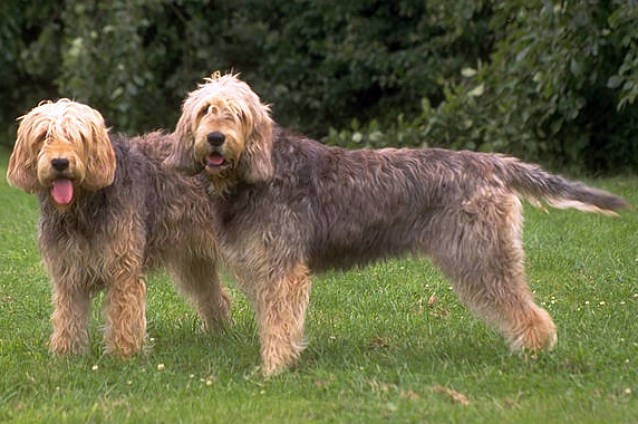 © Wikimedia.org/Machinecha, CC0
© Wikimedia.org/Machinecha, CC0
The Pachón Navarro is a Spanish breed of hunting dog from the autonomous community of Navarre, in northern Spain. It is one of five Basque breeds of dog, the others being the Basque Shepherd Dog, the Erbi Txakur, the Villano de Las Encartaciones and the Villanuco de Las Encartaciones. The Pachón is usually short-haired. The coat is highly variable, and may be unicoloured, bicoloured or tricoloured. The most common colours are black-and-white, chestnut-and-white, liver-and-white and orange-and-white, all with patches and specks of colour on a white background.: 561 (Source: Wikipedia.org, CC BY-SA)
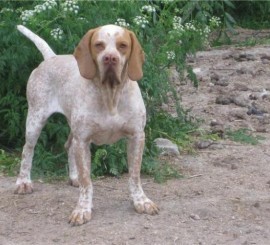
Pampas Deerhound (Portuguese: Veadeiro pampeano) is a Brazilian breed of hunting dog; it is also found in Argentina and Uruguay. It is common in Brazil, where it was first recognized by a national kennel club. The dogs were used to track, capture, and hunt deer (pampas deer), and thus earned the name Pampas Deerhound (in Brazilian Portuguese 'Veadeiro pampeano': veadeiro = deer-hound; pampeano = those who came from the pampas). It is still a widely preferred hunting companion to track other animals, such as wild boars. Medium-sized and long-legged with good muscles (denoting strength and hardiness), this dog breed is slender without seeming very thin and is physiologically built for speed. The tail is carried low, with a length that does not exceed the hocks. Some dogs may have a small fringe towards the lower part of the tail. (Source: Wikipedia.org, CC BY-SA)
 © Wikimedia.org/Silvia Corbucci, CC0
© Wikimedia.org/Silvia Corbucci, CC0
The Papillon (French pronunciation: [papijɔ̃], French for 'butterfly[-eared]'), also called the Continental Toy Spaniel, is a breed of dog, of the spaniel type. One of the oldest of the toy spaniels, it derives its name from its characteristic butterfly-like look of the long and fringed hair on the ears. A Papillon with dropped ears is called a Phalene. Papillons are very intelligent and self-assured dogs that have a very easy time learning new tricks. These dogs can be sociable with children and strangers, but are generally reserved around new people. They can also be socialized to get along well with other pets, but care should be taken with rambunctious pets or cats with claws, as they may injure them. If not properly socialized, Papillons can be distrustful and exhibit aggressive tendencies toward other dogs and people. Papillons may also be very playful and affectionate. Widely known as great companion dogs, they have the spirit and energy to keep up with active families, but can also be calm enough to be happy with sleeping in the arms of an equally affectionate owner. (Source: Wikipedia.org, CC BY-SA)
The Parson Russell Terrier is a breed of small white terrier that was the original Fox Terrier of the 18th century. The breed is named after the Reverend Jack Russell, credited with the creation of this type of dog. It is the recognised conformation show variety of the Jack Russell Terrier and was first recognised in 1990 in the United Kingdom as the Parson Jack Russell Terrier. In America, it was first recognised as the Jack Russell Terrier in 1997. The name was changed to its current form in 1999 in the UK and by 2008 all international kennel clubs recognised it under the new name. A mostly white breed with either a smooth, rough or broken coat, it conforms to a narrower range of sizes than the Jack Russell. It is a feisty, energetic terrier, suited to sports and able to get along with children and other animals. It has a range of breed-related health issues, mainly relating to eye disorders. (Source: Wikipedia.org, CC BY-SA)
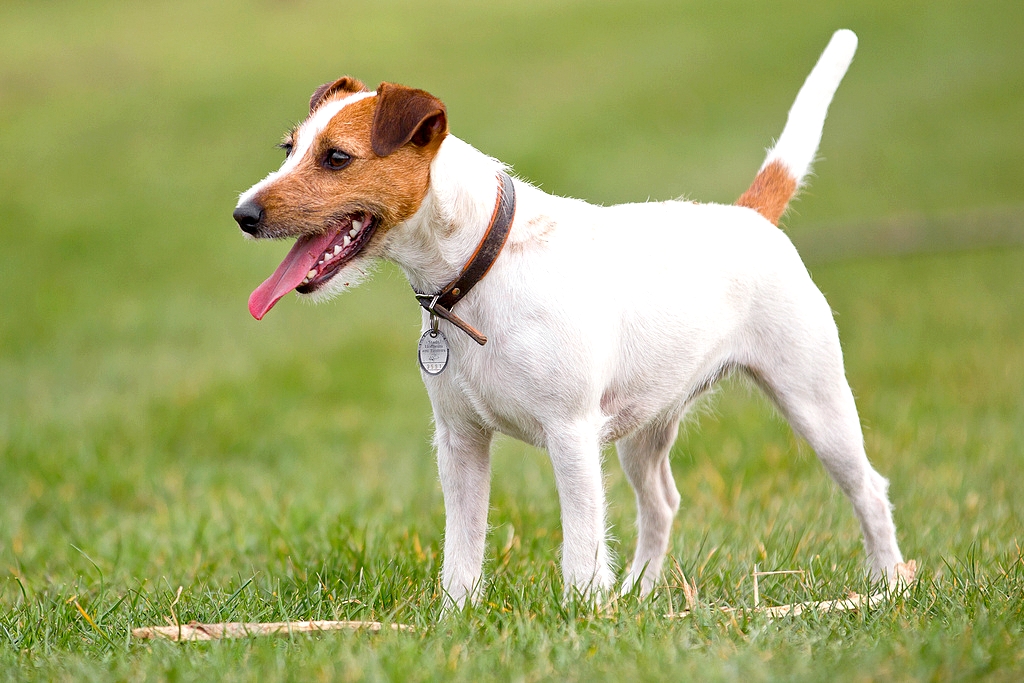 © Wikimedia.org/Julia Bettendorf, CC0
© Wikimedia.org/Julia Bettendorf, CC0
The Pastor Garafiano is a Spanish breed of sheep dog native to the island of La Palma in the Canary Islands. The name comes from the comarca of Garafía, in the north of the island, where the breed was most common, although specimens can be found throughout the island. The breed was officially recognized by the Real Sociedad Canina de España in 2003. Specimens typically weigh between 28 and 35 kg for males and between 24 and 30 kg for females. These are the weights that were given before, currently the weight is 35 to 46 kg for males and 25 to 35 kilos for females. (Source: Wikipedia.org, CC BY-SA)
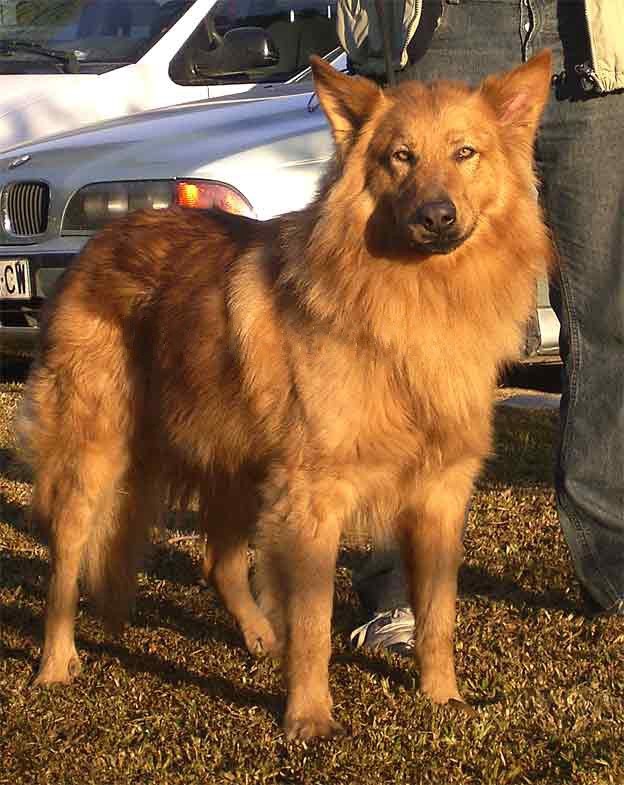 © Wikimedia.org/Javier Herrera Orta, CC0
© Wikimedia.org/Javier Herrera Orta, CC0
The Pastore della Lessinia e del Lagorai is an old Italian dog breed from the northeastern region called Triveneto. It is not recognized by any major kennel organisation. The Pastore della Lessinia e del Lagorai is a medium-sized, agile sheepdog of the 'lupine' type. The ears are large and triangular, being either erect, semi-erect (folded) or drooping. The coat is semi-long and the undercoat is thick. Typical colours include fawn, merle (blue or red), brown, and black. (Source: Wikipedia.org, CC BY-SA)
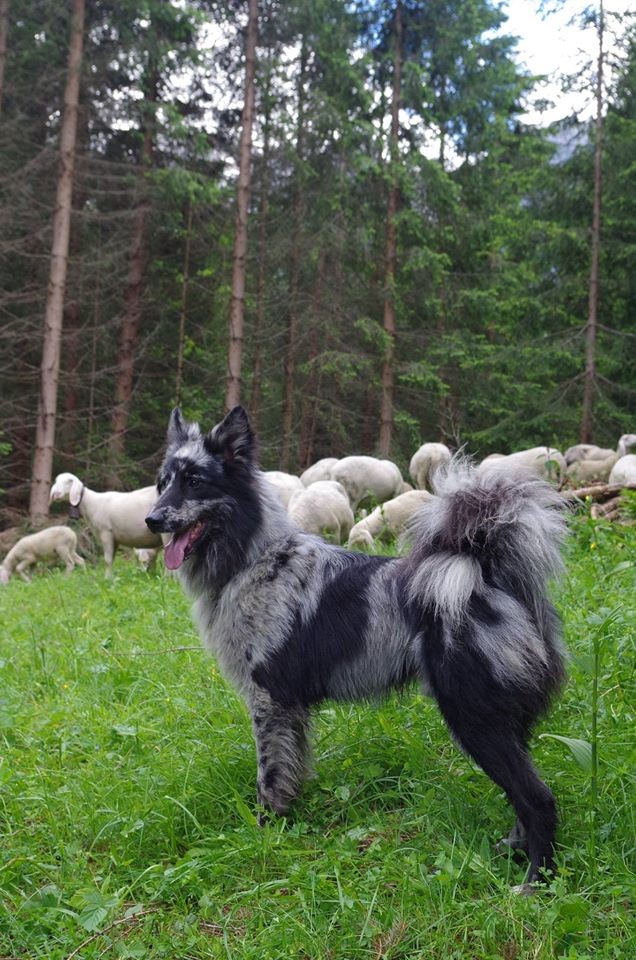 © Wikimedia.org/Dama di pietra, CC BY-SA
© Wikimedia.org/Dama di pietra, CC BY-SA
The Patagonian Sheepdog or Spanish: Ovejero Magallánico is a Chilean breed of sheepdog. It was bred in the late nineteenth and early twentieth centuries for sheep-herding work in the Magallanes y la Antártica Chilena Region of the southern part of Chilean Patagonia. It has a long rough coat and is well adapted to the harsh climate of the area. The Kennel Club de Chile publishes a breed standard. (Source: Wikipedia.org, CC BY-SA)
 © Wikimedia.org/Gernikatar, CC BY-SA
© Wikimedia.org/Gernikatar, CC BY-SA
The Patterdale Terrier is a breed of dog descended from the Northern terrier breeds of the early 18th century. An active little terrier that presents a compact, balanced image. As a working terrier, they have to be capable of squeezing through very small passages underground to follow quarry. This breed is worked far more than it is shown, and breeders are primarily concerned with the practicality of the breed. This terrier must have a strong neck, the fortitude to hold its quarry at bay, the ability to squeeze into tight burrows, and great flexibility and endurance. (Source: Wikipedia.org, CC BY-SA)
The Pekingese (also spelled Pekinese) is a breed of toy dog, originating in China. The breed was favored by royalty of the Chinese Imperial court as a companion dog, and its name refers to the city of Peking (Beijing) where the Forbidden City is located. The breed has several characteristics and health issues related to its unique appearance. Because of its desirable characteristics, the Pekingese has been part of the development of designer crossbreeds, such as the Peekapoo (crossed with a poodle) and Peke-a-tese (crossed with a Maltese). Modern breeders and dog show judges seem to prefer the long-haired type over the more traditional spaniel-type coat. (Source: Wikipedia.org, CC BY-SA)
The Pembroke Welsh Corgi (/ˈkɔːrɡi/; Welsh for 'dwarf dog') is a cattle herding dog breed that originated in Pembrokeshire, Wales. It is one of two breeds known as a Welsh Corgi. Pembroke Welsh Corgis descended from the Spitz family of dogs. The other is the Cardigan Welsh Corgi, which descend from the Teckel family of dogs, which also produced the Dachshund. The Pembroke Welsh Corgi has erect ears that are in proportion to the equilateral triangle of the head. The breed standard indicates that the ears should be firm, medium in size, and tapered slightly to a rounded point. The head should be 'fox-like' in shape and appearance. Pembroke Welsh Corgis differ from the Cardigan Welsh Corgi by being shorter in length, having smaller ears, and being slightly straighter of leg. The Pembroke Welsh Corgi has somewhat lighter markings on each side of the withers caused by changes in the thickness, length, and direction of hair growth. (Source: Wikipedia.org, CC BY-SA)
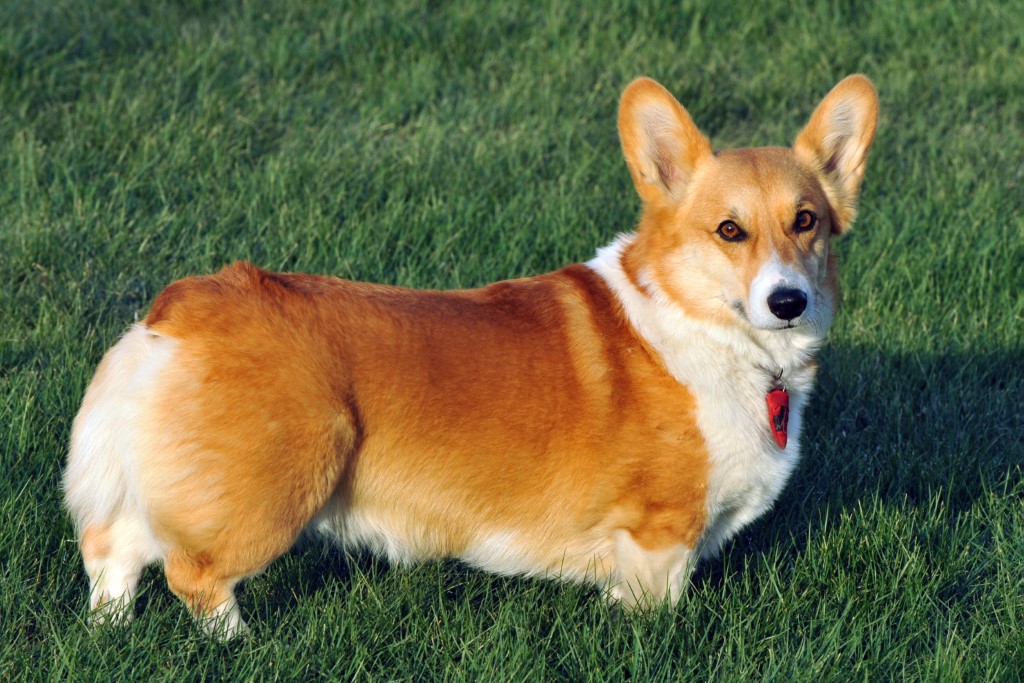 © Wikimedia.org/Pmuths1956, CC BY-SA
© Wikimedia.org/Pmuths1956, CC BY-SA
The Perro Majorero (English: Majorero dog) is a Spanish breed from the Canary Islands. Traditionally, it has been used as a cattle dog and guard dog. For various reasons, including the abandonment of the primary sector, or the introduction of foreign breeds on the island, the breed entered into a steep decline, which led to the edge of extinction. There was no specific plan of breeding and selection to change the fate of the Perro Majorero. Also, the existing speculation had reduced the breed's quality. For these reasons, the 'Association for the Conservation of the Perro Majorero' (ACPM) was founded, born as an initiative from the hands of breeders, owners and fans in order to safeguard and promote the survival of the Perro Majorero. (Source: Wikipedia.org, CC BY-SA)
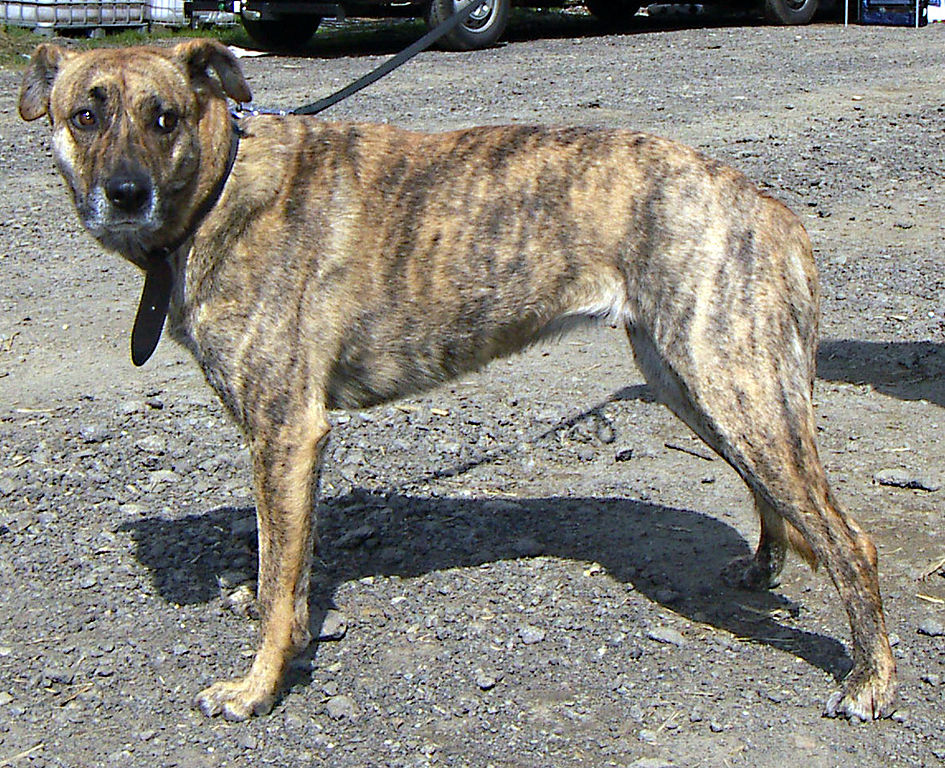 © Wikimedia.org/Steffen Heinz, CC BY-SA
© Wikimedia.org/Steffen Heinz, CC BY-SA
The Peruvian Hairless Dog, Peruvian viringo, naked dog, or Chimú dog is one of several breeds of hairless dog. It is native to Peru and it is usually raised as a pet. It has been officially recognized as part of Peru's cultural heritage. According to the FCI breed standard, the most important aspect of its appearance is its hairlessness. The dog may have short hair on top of its head, on its feet, and on the tip of its tail. In Peru, breeders tend to prefer completely hairless dogs. The color of skin can be chocolate-brown, elephant-grey, copper, or mottled. They can be totally one color or one color with tongue pink spots. Albinism is not accepted. The eye color is linked to the skin color. It is always brown, but dogs with light colors can have clearer eyes than darker-skinned dogs. (Source: Wikipedia.org, CC BY-SA)
The Petit Basset Griffon Vendéen (/pɛˌtiː bæˌseɪ ɡrɪˌfɒn vɑːndeɪˈɑːn/), or PBGV, is a breed of dog of the scent hound type, bred to trail hares in bramble-filled terrain of the Vendée district of France. The breed is known in the United States as 'Petit' or 'PBGV,' in England as 'Roughie,' and in Denmark as 'Griffon' or 'Petit'. The PBGV is one of six types of 'basset'-type breeds recognised by the Fédération Cynologique Internationale (FCI). Both males and females should be of similar size, range between 12.5 and 15.5 inches (32 to 40 cm) at the withers and between 25 and 40 pounds (15 to 20 kilograms). The dogs have a tousled appearance, with a harsh double coat that is both long and rough. The hair on the face and legs may be softer than body hair. The fur on the face resembles a beard and moustache. They usually have very long eyelashes. (Source: Wikipedia.org, CC BY-SA)
The Petit Bleu de Gascogne is a breed of dog of the scenthound type, originating in France and used for hunting in packs. Today's breed is the descendant of a large hunting dog. The Petit Bleu de Gascogne is not a small (petite) dog, the name comes from its use on small game. The Petit Bleu de Gascogne is directly descended from the Grand Bleu de Gascogne, a hound of ancient type. Smaller examples of the Grand Bleu de Gascogne were selected for hunting small game such as hare (the Grand Bleu de Gascogne was developed to hunt wolves, bears and boars) and eventually became a separate breed. It is a medium-large size dog, not a small dog, standing 52 to 58 cm (20 to 23 in) at the withers, with females slightly smaller. (Source: Wikipedia.org, CC BY-SA)
The Phalène (French pronunciation: [falɛn], 'moth[-eared]') is a toy dog breed, the drop eared variety of the Papillon ('butterfly[-eared]') dog. Both varieties can occur in the same litter. he Phalène is an intelligent dog. They learn new tricks easily. They are sociable with the family but reserved around new people. They need to be socialized to get along well with other pets or they can be distrustful and exhibit aggressive tendencies toward other dogs and people. Phalènes are playful and affectionate. They are lap dogs and companion dogs. They have enough energy to keep up with active families, but can also be calm enough to live in an apartment. Due to their rather high energy level, they demand regular exercise routine, as other companion breeds. Papillons are known as good watchdogs and they will alert their owner to changes in their environment. They can be noisy like many other toy dogs. The Papillon can withstand heat but is more sensitive to cold temperatures because of their single-coated fur, and should not be left outside unattended in cold weather. (Source: Wikipedia.org, CC BY-SA)
The Pharaoh Hound or Kelb tal-Fenek is a Maltese breed of hunting dog. It is traditionally used for rabbit-hunting in the rocky terrain of the islands; the Maltese name means 'rabbit dog'. The Kelb tal-Fenek is slender and graceful. The head is long and finely chiselled, with a slight stop. The coat is glossy and short. It may be chestnut or tan; white patches on the back, sides, shoulder or back of the neck are a disqualifying characteristic, but the tip of the tail may be white. The eyes are amber-coloured. The dogs have an unusual trait of 'blushing' when excited or happy, with their ears and noses becoming bright pink. It has little genetic pre-disposition to disease, and may be expected to live for some 11 to 14 years. (Source: Wikipedia.org, CC BY-SA)
The Phu Quoc Ridgeback (Vietnamese: Chó Phú Quốc) is a rare breed of dog from the island of Phú Quốc in Kiên Giang Province in southern Vietnam. It is one of three ridgeback breeds, the others being the Rhodesian Ridgeback and the Thai Ridgeback. It is not recognized by the Fédération Cynologique Internationale or any other major club. The Phu Quoc Ridgeback is one of the four native Vietnamese dog breeds, along with the Bắc Hà dog (Chó Bắc Hà), Lài dog (chó lài), Hmong Bobtail Dog (chó H’Mông). Medium sized with a hound shape, but with a larger head and well-developed muscles, the Phu Quoc Ridgeback is genetically and morphologically different from the Thai Ridgeback. All or part of the Phu Quoc's tongue is blue in color and the feet are webbed. Phu Quoc Ridgebacks are prized for their ability to run fast, swim well, and follow either a hot or a cold trail. As hunting dogs, they are known for their versatility, working both individually and in packs to take down a variety of prey including mice, fish, deer, and water buffalo. They also make excellent camp dogs, alerting to intruders. (Source: Wikipedia.org, CC BY-SA)
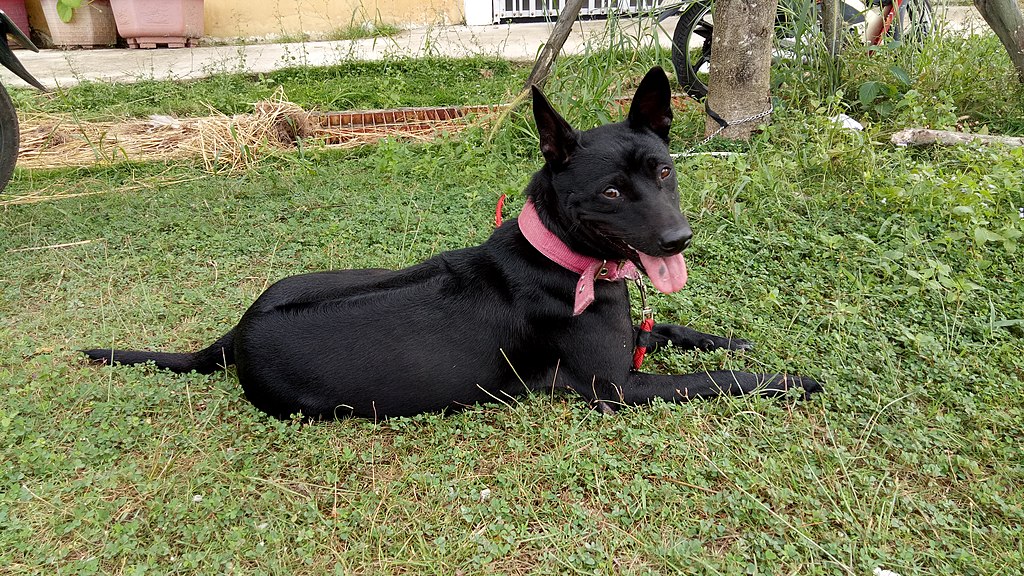 © Wikimedia.org/C63lc61, CC BY-SA
© Wikimedia.org/C63lc61, CC BY-SA
The Picardy Spaniel is a breed of dog developed in France for use as a gundog. It is related to the Blue Picardy Spaniel, and still has many similarities, but the Picardy Spaniel is the older of the two breeds. It is thought to be one of the two oldest continental spaniel breeds and was favoured by the French nobility, remaining popular for hunting after the French Revolution due to its weather resistant coat that enabled it to hunt in a variety of conditions and terrain. However its popularity waned following the influx of English hunting breeds in the early 20th century. Slightly smaller than an English Setter but larger than most of its spaniel cousins, it has no major health issues although as with many breeds with pendulous ears, it can be prone to ear infections. (Source: Wikipedia.org, CC BY-SA)
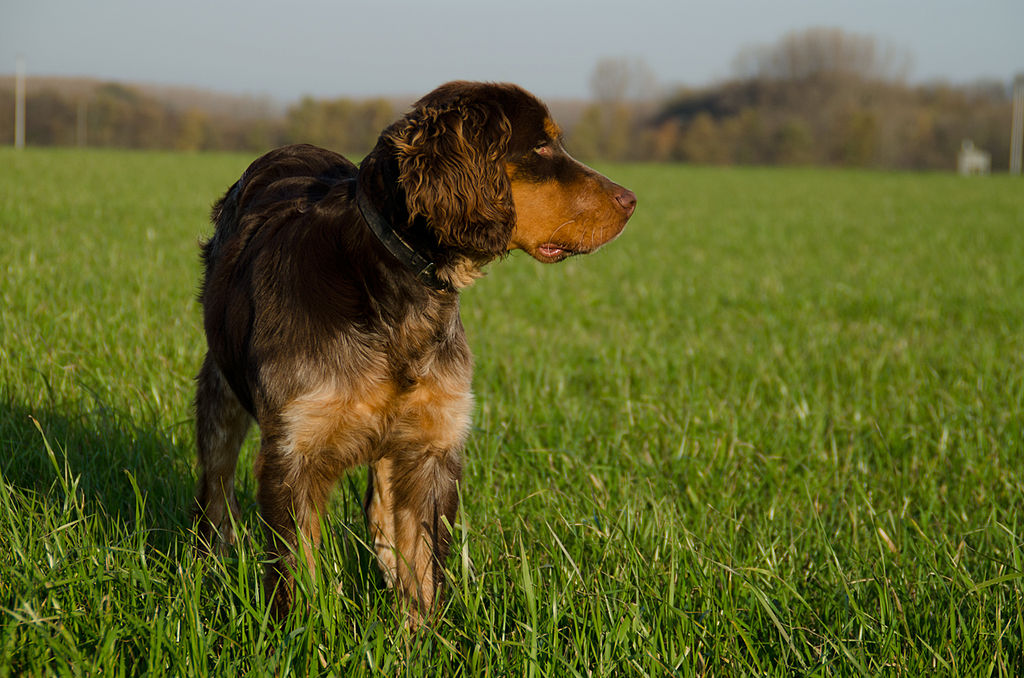 © Wikimedia.org/Rachelle Vafidis, CC BY-SA
© Wikimedia.org/Rachelle Vafidis, CC BY-SA
The Plott Hound is a large scent hound, originally bred for hunting bears. In 1989, the North Carolina General Assembly designated the Plott Hound as the official State Dog. The Plott Hound was first registered with the United Kennel Club in 1946. Plott Hounds were recognized by the American Kennel Club in 2006 and were exhibited at the Westminster Show in 2008. The Plott Hound is generally athletic, muscular, and agile in appearance, with a medium build. Unlike some other hounds, the Plott Hound's skin is not baggy. The Plott Hound is a very strongly built yet moderate hound, with a distinct brindle-colored coat. Its appearance suggests the capacity for speed, stamina and endurance. May have an identification mark on it that is used to identify the dog when hunting. Such a mark is not penalized in conformation shows. (Source: Wikipedia.org, CC BY-SA)
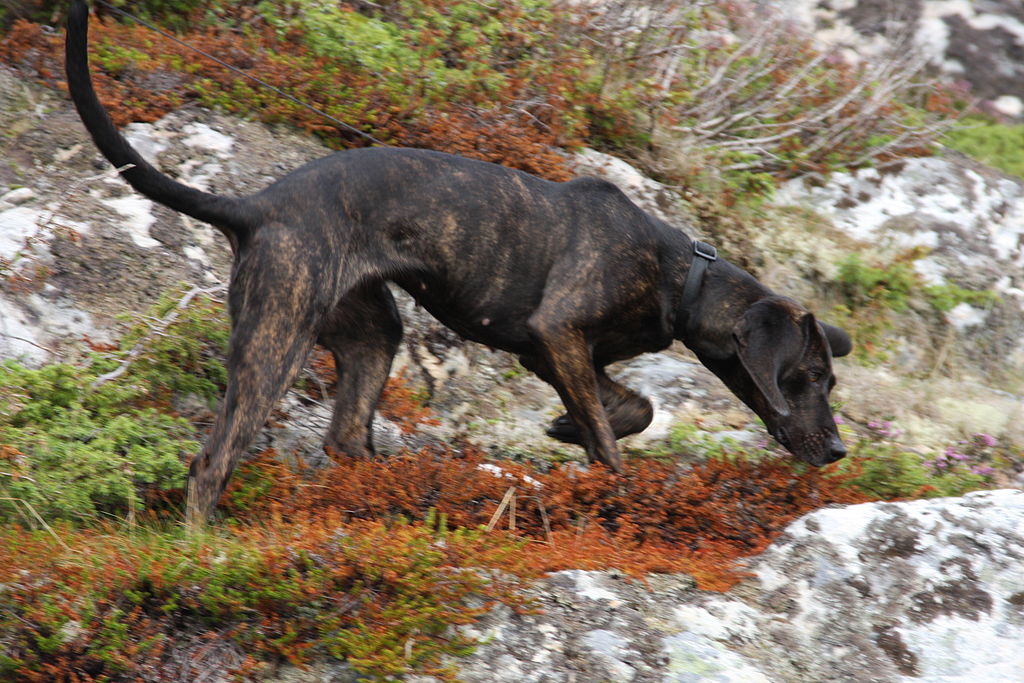 © Wikimedia.org/Eget bildearkiv, CC BY-SA
© Wikimedia.org/Eget bildearkiv, CC BY-SA

Time for recess! Post a comment, ask a question or write a review. Feel free to let us know what you think!
Heeft opzich wel goede oefeningen maar zou aanraden om ook op andere websites (gratis) te oefenen om een goed examen af te leggen
Ik heb 15 keer 50/50 gehaald op deze site ik ga naar het examencentrum en haal een 39
bij oefenexamen 1 zegt dat ik de gevarendriehoek op 50m moet plaatsen en bij 2 op 100m??
Vwb borden verkeersplein en rotonde slaat U hier de plank behoorlijk mis. Mag wel eens aangepast worden. Jammer.
Het zou handig zijn als jullie het op tyd laten gaan zoals op het examen. Groetjes David
ABS Nedir Nasıl Çalışır ? - https://www.diskfren.com/abs-nedir-nasil-calisir.html
Driving whit a tractor possible? What are the requirements? Can i drive whit a dutch T-licence?
het proefexamen op deze website is niet gedetailleerd genoeg waardoor de kennis volgens mij niet voldoende getest wordt, ik heb op meer dan 5 websites een proefexamen gemaakt en deze is zeer slecht. Gebruik aub de gratis website die de overheid heeft voorzien https://www.mijnrijbewijsb.be/, je zal zien dat de examens hier in ieder geval op deze website in veel groter detail gaan. (ik heb hier niets gekocht, enkel het gratis proefexamen gedaan)
Hallo,ik ben op de autokeuring geweigerd geweest omdat mijn rechter achtermistlicht gebroken is. Daar dit onderdeel tijdelijk onbeschikbaar is,heb ik dit hersteld met kleefband.De mistlichten werken nu allebij en ze hebben de goede rode kleur en toch ben ik opnieuw gewijgerd.hadden zij het recht mij hiervoor opnieuw te wijgeren?Zoja op welke basis? Dank u bij voorbaat.
Is de GPS verplicht in Antwerpen voor een examen praktische te gaan laten officiële doen categorie B bedankt
is er iemand die zijn examen al heeft gedaan en kan confirmeren dat dit hoe de test is
Amaai, wat moet dit moeilijk zijn voor een 17 jarige! Wel zeer leerzaam. Bedankt!